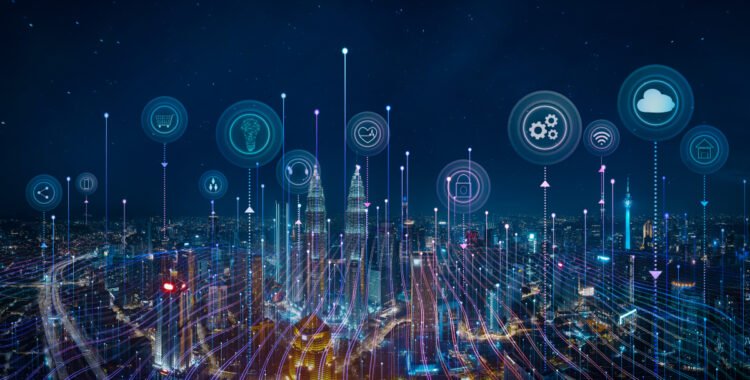Digital Public Infrastructure (DPI) is like the internet’s highways. It connects people. They can access services and goods online easily. Think of DPI as digital roads. These roads link everyone, everywhere. They make sharing and getting things simple. Just as real roads move cars and goods, DPI moves data and services. It’s key for digital life. It brings us together, making digital services a part of daily life.
******
Digital Public Infrastructure (DPI) is a network of interconnected digital systems that act as the foundation for various online services, empowering citizens and promoting economic growth. Essentially, DPI refers to the essential digital building blocks that enable efficient and secure delivery of public services, financial transactions, and data exchange for the benefit of the public.
Meaning of the term “Digital Public Infrastructure” (DPI)
The term “Digital Public Infrastructure” (DPI) literally breaks down as follows:
- Digital: Refers to the fact that it’s infrastructure built specifically for the digital world, existing online and facilitating digital interactions.
- Public: Indicates that it’s not owned or controlled by private companies, but rather developed and managed for the benefit of the general public by governments or other public institutions.
- Infrastructure: Similar to physical infrastructure like roads and bridges, it provides the foundational framework upon which other digital services and applications can be built and operate.
***
UNDP definitions of Digital Public Infrastructure
Here is United Nations Development Programme (UNDP) definition of Digital Public Infrastructure (DPI):
“Digital public infrastructure (DPI) is a shared means to many ends. It is a critical enabler of digital transformation and is helping to improve public service delivery at scale. Designed and implemented well, it can help countries achieve their national priorities and accelerate the Sustainable Development Goals.”
Definitions of Digital Public Infrastructure (DPI)
Sure, here are seven definitions of Digital Public Infrastructure (DPI):
- Digital Public Infrastructure is the digital foundation that enables the provision of digital services to citizens and the private sector.
- It is a shared resource that facilitates digital transformation and improves public service delivery at scale.
- DPI includes systems like the internet and GPS, which are some of the earliest examples of such infrastructure.
- It is a system built on trust, safety, interoperability, inclusion, and accessibility.
- DPI is defined as shared digital systems that are secure and interoperable, built on open standards and specifications to deliver and provide equitable access to public and/or private services at societal scale.
- It involves multiple stakeholders, including governments, tech companies, NGOs, and businesses, in its creation and delivery.
- DPI provides a robust framework for digital services, enabling governments to deliver efficient and citizen-centric goods while ensuring security, privacy, and accessibility.
***
Purpose of Digital Public Infrastructure
The purpose of Digital Public Infrastructure (DPI) is to foster an inclusive, efficient, and innovative public sector through technology. By leveraging open standards, enabling governance, and nurturing a competitive community of innovators, DPI aims to enhance public service delivery, promote transparency, and drive societal progress.
Top 3 Purpose
Empowering Inclusion: DPI paves the way for universal access to public services, ensuring every individual, regardless of their background, can benefit from technological advancements.
Boosting Efficiency: By streamlining processes and leveraging technology, DPI significantly reduces bureaucratic hurdles, making public services faster and more reliable.
Fostering Innovation: DPI creates a fertile ground for innovation, inviting a dynamic ecosystem of thinkers and creators to develop solutions that address public needs in novel ways.
***
Understanding the Digital Public Infrastructure (DPI)
Digital Public Infrastructure (DPI) is a dynamic and emerging concept. It is playing pivotal role in shaping the future of public services and governance acoss the world. It signifies a transformative approach towards creating an inclusive, efficient, and innovative public sector through technology.
The Composition of DPI
At its core, DPI is characterized by three fundamental components.
1. Open Technology Standards
First, it involves the establishment of networked open technology standards. These standards are designed with a focus on serving the public interest, ensuring that digital solutions are accessible, interoperable, and can be widely adopted.
2. Enabling Governance
Second, enabling governance plays a crucial role. This aspect pertains to the regulatory frameworks and policies that support the development and implementation of DPI, fostering an environment where technology can thrive in alignment with public values.
3. Innovative Community Engagement
Lastly, DPI is driven by a community of market players. This includes a diverse ecosystem of businesses, entrepreneurs, and innovators who compete and collaborate to enhance public programs. Their collective efforts are instrumental in pushing the boundaries of what can be achieved through DPI, leading to groundbreaking advancements and services that cater to the needs of the public.
***
UN High Impact Initiative
The UN High Impact Initiative: Digital Public Infrastructure (DPI) is a program aimed at accelerating progress toward the Sustainable Development Goals (SDGs) through inclusive digital transformation.
Key aspects of the initiative include:
- People-Centered Approach: DPI emphasizes people-centered and interoperable digital building blocks at a societal scale.
- Innovation: This approach allows local digital ecosystem players to innovate on top of these blocks, fostering new services for people.
- Crisis Response: With rights-based and people-centric DPI approaches, countries can advance a range of development objectives and respond better during crises.
- Sustainable Development Goals: Today’s decisions by countries on how to build their DPI will have lasting consequences on their opportunity to grow and innovate, and to achieve the SDGs by 2030.
- Five Key Pillars: By 2030, the UN High Impact Initiative on DPI aims to catalyze the collective action necessary, working with leaders and scalable models to unlock targeted support for DPI implementation and strengthening in 100 countries by ensuring that DPI is safe, accessible, affordable, green, financed, and future ready.
- Universal Safeguards: This pillar calls for the creation and adoption of a universal safeguard framework by all member states and stakeholders to collectively chart a unified path forward to ensure fundamental human rights are universally protected.
***

Evolution of Digital Public Infrastructure (DPI) in India
India’s journey with Digital Public Infrastructure (DPI) began in 2009 with the launch of Aadhaar, a unique digital identification system for citizens. DPI goes beyond just IDs, encompassing platforms like secure digital payments and data exchange solutions that work together to create a robust foundation for the digital economy.
India’s journey with DPI has been a remarkable one. The DPI journey has been transforming from a simple digital identification system to a comprehensive infrastructure that empowers citizens and facilitates economic growth. As India continues to embrace new technologies and expand its DPI capabilities, its positive impact on the lives of its citizens is sure to be profound.
India’s approach to DPI is embodied in India Stack, a set of three foundational components:
- Digital Identity (Aadhaar): This unique ID system provides a verifiable and secure way to identify individuals online, streamlining access to various services and benefits.
- Real-time Fast Payment (UPI): This innovative platform enables instant and secure digital payments, empowering individuals and businesses to conduct transactions seamlessly.
- Account Aggregator (built on DEPA): This framework allows individuals to share their financial data securely with authorized entities, enhancing financial inclusion and facilitating access to credit and other financial products.
Several factors fueled the growth of DPI in India
- Favorable Demographics: India’s young and tech-savvy population readily embraced digital solutions.
- Expanding Middle Class: The growing middle class created a demand for online services and digital financial products.
- Shifting Digital Behavior: Increased internet penetration and mobile phone usage led to a surge in digital adoption.
Digital India and Digital Public Infrastructure
The government played a crucial role in promoting DPI through initiatives like Digital India, launched in 2015. This initiative focused on improving internet access, particularly in rural areas, through projects like the BharatNet scheme. Additionally, schemes like the Telecom Development Plan and Aspirational District Scheme further supported digital infrastructure development.
The impact of DPI has been significant. Studies suggest that by 2030, India’s DPIs could potentially contribute three times the current economic value. This growth highlights the potential of DPI to unlock economic opportunities and improve overall well-being.
Looking ahead, the future of DPI lies in embracing new technologies. Integrating Artificial Intelligence (AI) and Web 3.0 applications into DPI can further enhance its capabilities, paving the way for a more efficient, secure, and inclusive digital ecosystem.
***
SDGs and DPI: Bridging Digital Innovation with Global Goals
The journey towards the Sustainable Development Goals (SDGs) is a path paved with digital innovation. At the heart of this transformative quest lies Digital Public Infrastructure (DPI), a cornerstone for harnessing the power of digitalization to push forward the global agenda for a sustainable future. DPI isn’t just about technology; it’s about creating digital environments that are inclusive, ensuring that the benefits of digital advancements reach everyone.
In the pursuit of sustainable development, the traditional, isolated approach to digital solutions falls short. DPI stands out by advocating for a unified, people-first strategy. It lays down the digital foundations that encourage local innovators to build upon, leading to the birth of services that genuinely meet the needs of communities. By centering on human rights and focusing on the people, DPI helps nations navigate through challenges and seize development opportunities more effectively, especially in times of crisis.
The choices made today regarding the development of DPI will significantly impact a country’s growth, innovation capacity, and its success in achieving the SDGs by the 2030 deadline. Inspired by the G20 Leaders Declaration in 2023, DPI emerges as a pivotal force for change, offering a fresh impetus to meet the SDGs across all areas. As technology evolves rapidly, there’s a unique chance for communities to experience a revolution in how they access and benefit from digital services, from financial inclusivity through digital cash transfers to advancements in e-health. Investing in DPI is not just investing in technology; it’s investing in a future where digital solutions empower everyone, everywhere.
***
G20 and the Rise of Digital Public Infrastructure (DPI)
In an era marked by ongoing challenges and upheavals, nations are striving to lay down resilient and inclusive digital frameworks that cater to both public and private sectors. As they progress into the next phase of their digital evolution, it’s crucial for both developed and developing economies to adopt an approach to infrastructure that champions inclusivity, empowerment, and innovation. The G20 presidency of India stands as a pivotal moment to rally the global community towards this critical mission.
The COVID-19 pandemic underscored the indispensable role of a robust digital backbone for countries worldwide, highlighting the urgency of developing such capabilities swiftly to combat crises. This need for digital resilience was particularly pronounced in low- and middle-income nations. A World Bank analysis of 178 programs across 85 countries revealed that those with pre-existing investments in essential digital infrastructures, including databases, identification systems, and payment platforms, were significantly more effective at deploying social assistance programs during the pandemic, thereby extending their reach to a larger number of beneficiaries.
The G20, a group of the world’s leading economies, recently recognized the significance of Digital Public Infrastructure (DPI) in shaping the future. Under India’s 2023 presidency, the G20 achieved a historic consensus on DPI, aiming to create a framework for global digital commons and ensure its accessibility.
DPI refers to the underlying digital frameworks like digital IDs, payment systems, and data-sharing platforms that are essential for various online services. These digital “building blocks” enable governments to deliver services efficiently, empower citizens financially, and foster economic growth.
India, a frontrunner in DPI development through initiatives like Aadhaar and UPI, played a key role in propelling this conversation forward. This resulted in two significant outcomes:
Global Digital Public Infrastructure Repository: This repository will serve as a knowledge hub, sharing best practices and fostering collaboration across nations.
Social Impact Fund: This fund aims to support developing countries in building their own robust DPI frameworks, bridging the digital divide and promoting inclusive growth.
The G20’s focus on DPI signifies a global shift towards collaborative efforts in building a secure, interoperable, and inclusive digital ecosystem. This paves the way for a future where everyone can benefit from the opportunities offered by the digital world.
***
By bridging technology with governance and market dynamics, Digital Public Infrastructure paves the way for more responsive, transparent, and effective public services. This, in turn, enhances the quality of life for citizens and fosters a more engaged and empowered society.
(Copyright@IndiaCSR.in)
Also Read:






